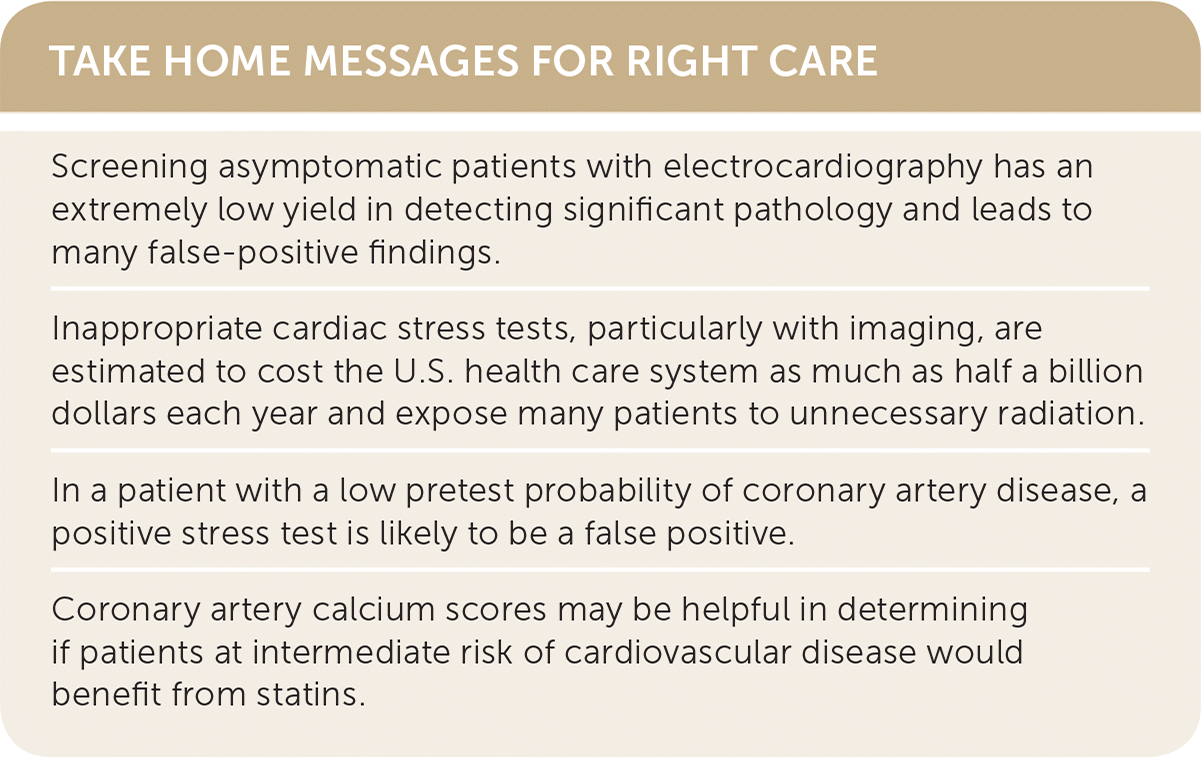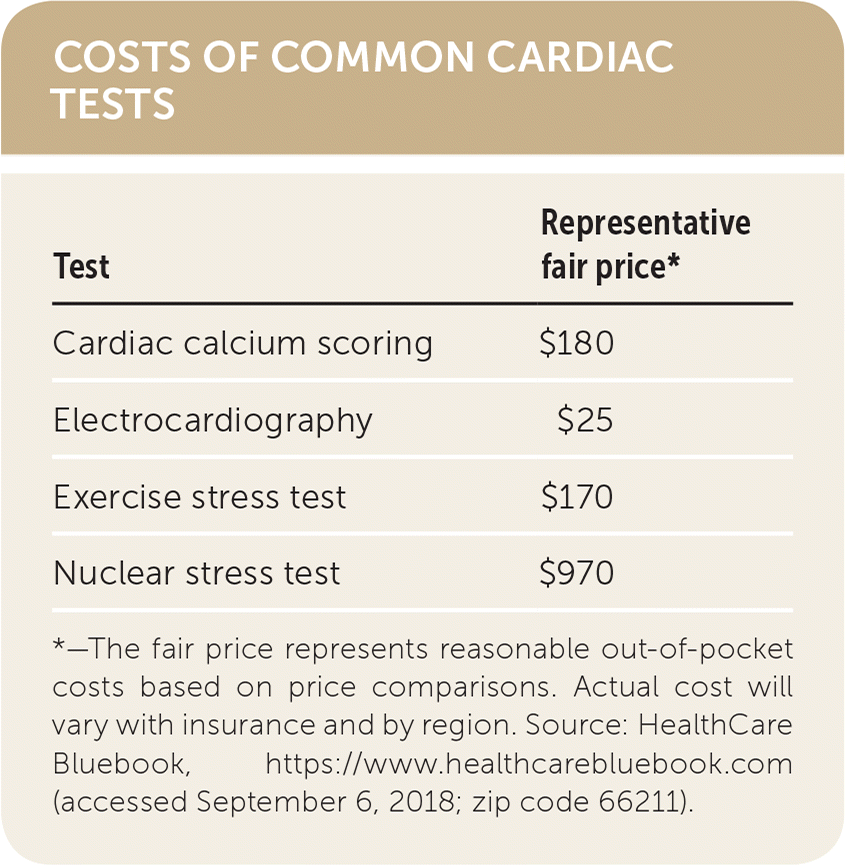
Am Fam Physician. 2018;98(10):561-563
Related editorial: Introducing Lown Right Care: Reducing Overuse and Underuse.
Author disclosure: No relevant financial affiliations.
Case Scenario
A 62-year-old white man with hypertension presents for a routine physical examination. He does not smoke and has a body mass index of 32 kg per m2. After being sedentary for many years, he is about to begin an exercise program. His wife thinks he should get his heart tested before beginning to exercise. The patient does not have chest pain or pressure, dyspnea, or palpitations. His blood pressure is 125/70 mm Hg, total cholesterol is 205 mg per dL (5.31 mmol per L), low-density lipoprotein cholesterol is 118 mg per dL (3.06 mmol per L), high-density lipoprotein cholesterol is 45 mg per dL (1.17 mmol per L), and fasting glucose level is 88 mg per dL (4.9 mmol per L). Based on the American College of Cardiology and American Heart Association risk calculator (available at https://www.mdcalc.com/ascvd-atherosclerotic-cardiovascular-disease-2013-risk-calculator-aha-acc), his estimated 10-year risk of a cardiovascular event is 10.6%.
You perform electrocardiography (ECG), which shows nonspecific abnormalities, but the patient insists that you also order a stress test. A nuclear stress test shows a small area of reversible myocardial ischemia. Subsequent cardiac catheterization reveals nonobstructive coronary artery disease (CAD), for which lifestyle modifications, a moderate-intensity statin, and optimal control of blood pressure are recommended.

| Screening asymptomatic patients with electrocardiography has an extremely low yield in detecting significant pathology and leads to many false-positive findings. |
| Inappropriate cardiac stress tests, particularly with imaging, are estimated to cost the U.S. health care system as much as half a billion dollars each year and expose many patients to unnecessary radiation. |
| In a patient with a low pretest probability of coronary artery disease, a positive stress test is likely to be a false positive. |
| Coronary artery calcium scores may be helpful in determining if patients at intermediate risk of cardiovascular disease would benefit from statins. |
Clinical Commentary
Cardiovascular disease is the leading cause of death worldwide.1 More than 25% of individuals who experience acute myocardial infarction have no previous symptoms,2 making risk stratification essential to help target appropriate preventive interventions. Risk stratification should be performed using a clinical assessment of risk factors and exercise tolerance, as well as a validated risk tool. Inappropriate use of diagnostic tests to screen for cardiac disease in asymptomatic patients may lead to further testing and invasive procedures that are costly and potentially harmful, and have no clear benefits compared with clinical history and evaluation alone.
ELECTROCARDIOGRAPHY
Routine screening of asymptomatic patients with ECG has a very low yield in detecting significant pathology and leads to many false-positive findings. Performing ECG as part of a health maintenance examination does not lower the risk of future cardiovascular events or cardiac death.3 The U.S. Preventive Services Task Force (USPSTF) recommends against screening with ECG to predict CAD in low-risk patients and found insufficient evidence to assess the benefits and harms of screening in individuals at intermediate or high risk.4
STRESS TESTS
Stress ECG (exercise stress tests), stress echocardiography, and myocardial perfusion imaging are commonly used to evaluate patients for CAD. However, it is unclear if these tests add any prognostic benefit beyond a careful evaluation of underlying cardiovascular risk factors in patients without cardiac symptoms. Inappropriate cardiac stress tests, particularly when done with imaging, are estimated to cost the U.S. health care system as much as half a billion dollars each year and expose many patients to unnecessary radiation.5
It is important to understand that stress testing detects only significant coronary stenosis and does not identify nonobstructing plaques, which are a common cause of myocardial infarctions. In fact, because many patients who present with an acute myocardial infarction have no prior obstructive CAD, normal results on a stress test might be falsely reassuring. On the other hand, in a patient with a low pretest probability of CAD, a positive stress test is likely to be a false positive.6,7
Many persons with a false-positive result on stress testing undergo subsequent testing and interventions such as cardiac catheterization and revascularization. Up to 3% of persons who get stress tests undergo cardiac catheterization,8 and 1.7% of catheterizations lead to severe adverse reactions, mostly in persons without CAD.9 Screening for CAD with stress tests has not been shown to affect clinical outcomes or further inform the use of risk-reducing therapies beyond a good clinical assessment.10
CORONARY ARTERY CALCIUM SCORE
The use of the coronary artery calcium score using non–contrast-enhanced computed tomography of the chest is becoming more common. Coronary artery calcium screening can detect plaque in the coronary arteries, which is broadly correlated with the risk of cardiac events. The coronary artery calcium score has a low false-negative rate, and a low score is highly predictive of a good outcome (999 out of 1,000 persons with a score of 0 and 996 out of 1,000 persons with a score of less than 100 have no cardiac events within one year).14
Randomized trials have not demonstrated that screening with a coronary artery calcium score saves lives or prevents cardiovascular events. The USPSTF found insufficient evidence to recommend the use of nontraditional risk factors, including coronary artery calcium score, to prevent cardiovascular events.15 The question we need to ask is: how will this test change therapy? For asymptomatic patients at intermediate risk or patients at low risk with a family history of CAD, low coronary artery calcium scores may discourage the use of lipid-lowering therapy because statins have not been shown to affect cardiac outcomes in persons with low scores. For patients with low or high clinical risk of CAD, a coronary artery calcium score is not helpful because clinical risk stratification guides risk factor modification. Downsides of screening with the coronary artery calcium score include cost, radiation exposure (although low), and incidental findings that may result in downstream tests and patient anxiety. It also may not give accurate risk estimates in patients with renal failure and uremia.16
Annually, more than 10 million stress tests and approximately 1 million diagnostic cardiac catheterizations are performed in the United States.7 In patients who are low risk and asymptomatic, risk stratification is best determined with the history, physical examination, and use of established modalities such as a validated risk score rather than ECG, stress test, or coronary artery calcium score. Patients who have CAD or are at high risk should receive statins and counseling on lifestyle modifications regardless of stress test results or coronary artery calcium scores. Coronary artery calcium scores may be helpful in determining if patients at intermediate risk would benefit from statins, whereas stress testing may be misleading in these patients because of its inability to detect nonocclusive plaque and its high false-positive rate.

| Test | Representative fair price* |
|---|---|
| Cardiac calcium scoring | $180 |
| Electrocardiography | $25 |
| Exercise stress test | $170 |
| Nuclear stress test | $970 |
Resolution of Case
This asymptomatic, 62-year-old white man with hypertension and a 10-year risk of a cardiovascular event of more than 10% would benefit from a low- to moderate-dose statin and low-dose aspirin, according to the USPSTF.17,18 Further screening for CAD would not be warranted because it has not been shown to reduce mortality, and a coronary artery calcium score to assess for plaque and guide treatment would be considered only if the patient is unable to tolerate statin therapy.
The authors gratefully acknowledge receiving funding support from the Robert Wood Johnson Foundation grant 75223 for work on the Lown Right Care department.
